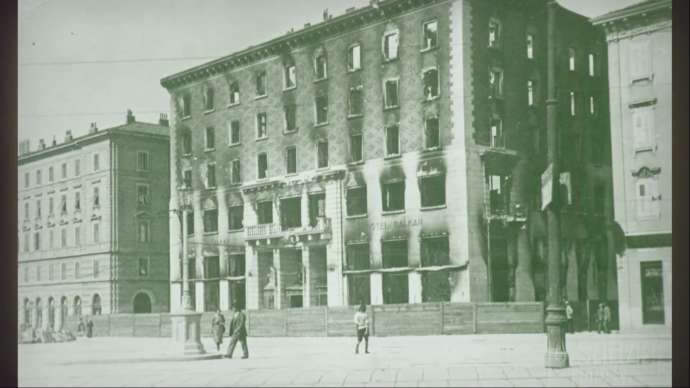STA, 28 February 2020 - The arson of the Trieste National Hall (Narodni dom) by the Fascists a century ago marked the start of a painful period for the Slovenian community that ended up on the Italian side of the border. A documentary shedding light on that event and what followed will premiere in Ljubljana tonight.
"It's a painful and often overlooked and too often simplified story about our western border and about Primorska. The arson of National Hall was the start of that cruel story and I dear say the beginning of Fascism in Europe," the author of Arson (Požig) Majda Širca has told the STA in an interview.
The Trieste National Home was built in 1904 to the design of architect Max Fabiani (1865-1962). It was commissioned by the Trieste Savings and Loan Society; as a Slovenian cultural centre, it was home to a theatre, hotel, savings bank, a ballroom, a print shop; most Slovenian associations.
"Trieste at the time of Austria-Hungary was a multi-cultural city in which various nations and cultures lived together. By building the National Hall, Slovenians made it clear they weren't going to build churches like other nations. They decided to build a space of multi-cultural dialogue (...)"
"Slovenians knew they needed a representative, visible and effective place in the middle of Trieste. Slovenians at the time lived on the city's outskirts, in small villages. They were a rural population that supplied Trieste but they didn't have their visible place in the city centre," Širca said.
The project was a thorn in the flesh of bigots who looked down on Slovenians, calling them schiavi (Italian for slaves). After the end of First World War, tensions escalated in Trieste, with a number of rallies held.
On 13 July 1920, one of those rallies escalated into a violent conflict in which shouts were heard that a Slav had killed an Italian. A mass of people then stormed the National Hall and torched it, historian Kaja Širok says in the film. Witnesses say that police and army officers stood by watching.
"That event later went down in history as 'the Slavic Crystal Night'. On that day several stores, print shops and buildings owned or managed by Slovenians were torched," the historian said.
Badly damaged in the fire, the National Hall was rebuilt between 1988 and 1990 and now houses the headquarters of the college of modern languages for interpreters and translators, part of the University of Trieste, as well as a Slovenian information centre.
The Slovenian community has been unsuccessfully trying to get back the building, with their hopes placed in this year's centenary when the presidents of Slovenia and Italy, Borut Pahor and Sergio Mattarella, are expected to meet in Trieste to mark the anniversary.
The film Arson also features excerpts of old comments by Boris Pahor, the 106-year-old Slovenian writer from Trieste who witnessed the National Hall arson and has often spoken out about the issue and has often said that Fascism in Europe started with that arson.
The year the National Hall went up in flames Slovenian territory was subject to barter, Širca says. Under the Treaty of Rapallo, signed in November 1920 by the Kingdom of Serbs, Croats and Slovenes (later Yugoslavia) and the Kingdom of Italy, a third of Slovenian ethnic territory was awarded to Italy.
Ethnic Slovenians were put under huge pressure, faced assimilation attempts, denial of their language and territory, turbulence which Širca seeks to portray in her documentary, although she believes each of the key events included would merit a film of its own.
The film traces individuals' stories to the Basovizza victims, the Slovenians that were the first victims of fascism in 1930, the Fascist and Nazi occupation, the concentration camps and executions, the 1975 Treaty of Osimo and the establishment of a new border between Slovenia and Italy.
The documentary also touches on the foibe, the Karst pits where the victims of post-WWII reprisals by Yugoslav Communists were thrown.
"If you visit Basovizza, there are two monuments there not far from one another. One is an Italian monument to foibe, where every year the complex and complicated history of this space is sadly drastically simplified and abused, and the other a monument to the Basovizza victims.
"There's 15 years of history between the two, but I believe it always needs to be read in the context of that space. You cannot isolate one event from the other, just like you cannot but link the things together," said Širca, who served as Slovenia culture minister between 2008 and 2011.
She is concerned about what she sees as a dangerous loss of memory in Slovenia and elsewhere: "We know the past is being adapted, history is being horse traded and facts are being dressed in new clothes. Like in the past the new clothes are better worn trendy and we know how hard such simplification of history hits the Slovenian community."
The film, which will premiere at the National Museum of Contemporary History before being shown on TV Slovenija on Sunday night, is her contribution so that younger generations should learn about that difficult and multi-layered history: "If someone drums but one truth into their heads, it sticks. It's what is happening in the world today."






